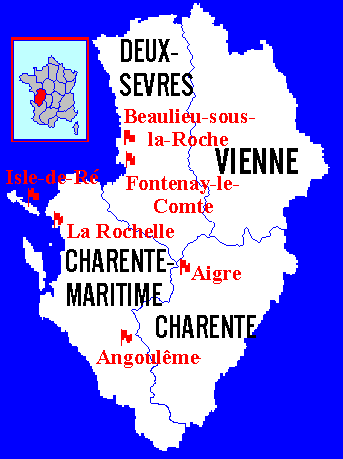![]()
|
![]()
| ||||||||
|
The Simard family can be traced back to the mid-1500s to Angoulême in western France where records document Antoine Simard's marriage to Marguerite Soûlot, and then to Francoise Berthon. From this information, we also know the names of Antoine's six children: Pierre -- the only child of the first marriage -- and Marsault, Vincent, Raymond, Jeanne and Marguerite -- all children of Antoine's second marriage. At Antoine's death in 1588, his eldest son from his second marriage, Marsault, became the head of the household. Pierre by this time had already left the family after the death of his mother many years before. Marsault and his wife, Léonarde Berthoume, inherited the Simard family homestead at Angoulême.
| |||||||
|
Unfortunately,
Angoulême, like much of western France, was virtually destroyed in the fighting between Catholics and Protestants during the Wars of Religion, and the Simards lived in poverty in the aftermath of the continuing warfare. Not surprisingly, famine and plague swept France in war's wake.
These were difficult times. Their son, Marsault (II), marries Ozanne Boozer, and begins to raise a family at Saint-Vincent, in the township of Puymoyen, Angoulême. Unfortunately, he dies young, leaving Ozanne by herself to fend for their four children: Marsault, Pierre, Antoinette and Marguerite. Pierre, the second son, was born about 1602, and went on to become a stone mason by trade. He worked for a while in Angoulême, leaving the family farm to his elder brother, Marsault. On May 25, 1631, he married Catherine Boutier. Sadly, Catherine soon dies. Several years later, on December 2, 1635, Pierre remarried, to Suzanne Durand, the daughter of Louis Durand and Françoise Levreau. The couple's first son, Noël, was born some time around 1637. At about this time, the family acquired the "dit" name (nickname) of Lombrette, meaning "a little shade." There are a couple of theories about the origin of this nickname -- one tradition holds that the Simard family was not tall and thus cast small shadows, another maintains that a village of this name existed in the neighborhood of Angoulême, and so the family was simply called "the Simards from Lombrette." The next recorded mention of Pierre is from January 30, 1655, when he and his neighbors, Robert Paré and Mathurin Meusnier, received a concession of land from Jean Lauzon, Governor of New France. So, he must have already been back in Quebec by late 1654, because this consession was for work performed. In 1657, he was back in France for a time, because on May 28th of that year, he is reported to be in Angoulême for the marriage contract of his nephew, Jacques Simard.
In May of 1657, Pierre and his son Noël headed back to New France on the ship "Le Taureau". His wife, Suzanne, and his daughter refused to make the dangerous journey. The men arrived to Quebec on June 21st, 1657. Suzanne Durand never followed her husband to Canada. In fact, when she wrote her will on October 27th, 1666, she considered herself a widow, and left all her worldly possessions to a Marie Baurye. Almost immediately, Pierre found work as a mason on the Beaupré coast with Etienne de Lessard, first seigneur of Île-aux-Coudres. While working for Msr. Lessard, Pierre obtained a small holding in the seigneury of Beaupré. During this time, Noël helped his father clear and cultivate their new land, and also found a wife: Mary-Madeleine Racine, the daughter of Étienne Racine and Marguerite Martin. Madeleine's family was one of the oldest and most respected in New France. Her mother, Marguerite, was the daughter of royal pilot Abraham Martin,and was the first French settler to be baptized on Canadian soil. Abraham Martin gave his name to the "Shores of Abraham" and the " Plains of Abraham" that played such a significant role in the history of Quebec. Noel and Madeleine's wedding, on Tuesday, November 22, 1661, was held at Château Richer, where the presbytery and manor house for the seigneury were located.
Seventeen months later, their first child, Pierre, was born. Eighteen months after that, their second child, Noël, joined the family. In 1667, Noël, Sr., and his father Pierre, make arrangement to take possession of Pierre Gibouin's land, who wants to finish his days in France. Unfortunately, they could not produce sufficient cash immediately to complete the purchase. But, they were in the good graces of Monsignor Laval, the first Bishop of Quebec, who promised to help them with his own money if necessary. Reassured, by the 16th of October, 1667, they formally took possession of Gibouin's estate. But Noël's family had grown quickly. His wife, Madeleine, only 30 years old, already had nine children. With such a large family to support, Noël had trouble meeting the debt he contracted to purchase Gibouin's land. Fortunately, Monsignor Laval was a man of his word, and he lent the remaining money to the Simards to pay off their debt. In exchange, Noël and his wife agreed to go to Baie Saint-Paul to help Monsignor Laval make the lands there productive and profitable.
Pierre Simard, a grandfather now, remained with his two grandsons, Pierre and Noël, on the Beaupré land, while the rest of the family committed to work for five years on "the land from the St-François-Xavier coast of the Petite River to those which extend along the Gouffre River, except for that already being exploited by Claude Bouchard." It was actually a very good deal for Nöel. Claude Bouchard, and some other pioneers, had already started to work on these lands. Noël would oversee the property and would be able to keep half of the animals born from the herd he maintained, with the remainder going to Monsignor Laval. While he had some buildings to build, the lumber mill and flour mill were already started. In short, the land was already well-equipped with the necessities for running a successful farm -- mills, livestock (a cock and nine hens, six large oxen, three bulls, six cows with their calves, and six pigs), produce and grains (hay, corn, oats, barley and peas). In 1679, Monsignor Laval sent Pierre Tremblay to assist Simard. That same year, Simard was granted his own land on the Petite River. The following year, Noël established his family at Baie St. Paul, close to Cap Maillaird (now called Petite-Rivière-St.-François). The Simard family flourished, growing to 14 children, and their own grandchildren. Some of Noël's children moved on to become the Seigneurs of their own lands up and down the St. Lawrence valley. One branch of his son Noël's family moved across the St. Lawrence to the Kamouraska area, and then across northern Maine to the Madawaska/St. John River area. Tragedy struck in the summer of 1714, when an epidemic spread quickly up the coast. Noël Simard, 78 years old, succumbed to this plague and died in the arms of his wife. The following summer, the family met to conduct legal inventory of their father's possessions: titles and various papers, personal items, including an axe; a saw; a barrel of salted eel; 15 pounds of tin; a bag of tobacco. These clues tell us much about Noël's life -- that he was a laborer, a carpenter and sawyer, an eel fisherman, a farmer, perhaps even a tin smith -- a man who worked hard, met every challenge, and left a prosperous land for his children. In 1726, Madeleine Racine, more than 80 years old, passed away. Noël Simard's family would become one of the largest in Quebec and would help colonize various parts of the country from Saguenay, Abitibi, and Témiscaminque, to the Rivière la Paix. In Baie St. Paul, there is a monument to Noël Simard, Madeleine Racine, and their daughter, Rosalie Simard, the first child of French origin born in Baie St. Paul. Noël and Madeleine Racine Simard had 14 children:

| ||||||||
|
||||||||
| ||||||||
![]()
HOME
|
Writing Resource Page
|
Genealogy Page
|
INDEX
|
|
![]()
|
|
||||||||
|
|||||||||
|
|||||||||
|
|||||||||










